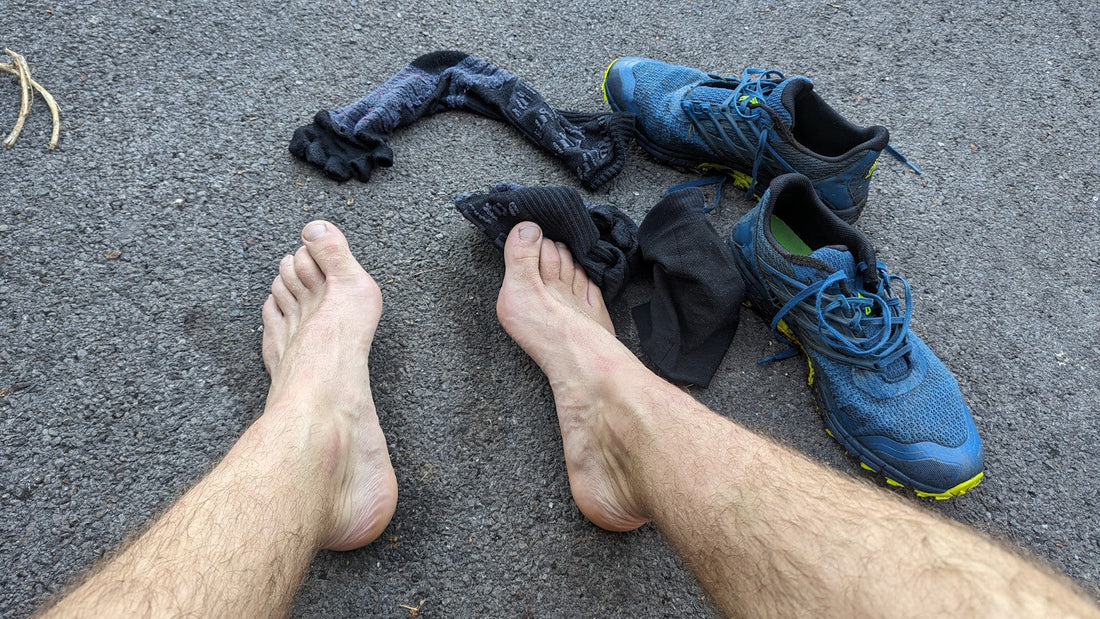Do you have itchy, flaky feet? Have you started to suspect that it’s more than just a bit of dry skin on your hooves and that fungus has moved in?
Whilst dry skin can be uncomfortable, it’s common and perfectly normal unless it's cracking or bleeding. Your parched paws may need some tender care, but no microbial squatters are hanging out on your skin. Athlete’s foot, however, is a fungal gatecrasher that can be a pain in the a***, and you’ll need some help from antifungals to permanently eject it.
We’re here to help you figure out exactly what’s going on with your feet. Get comfy and put up your trotters - we’re breaking down the difference between athlete’s foot and dry skin, how to treat ‘em, and when to call in the pros.
Meet the culprits
Athlete’s Foot (aka Tinea Pedis)
Athlete’s foot is a fungal infection caused by tiny fungi called dermatophytes. These annoying, foot-loving microorganisms love warm, damp environments. That’s why they’re mostly found hanging out in gym showers, swimming pools or sweaty trainers looking for their next victim.
According to the NHS, athlete’s foot is highly contagious. It can easily spread through shared towels, shoes, or walking barefoot in communal areas.
Anyone can get athlete’s foot, not just athletes. Tinea Pedis isn’t choosy about your workout habits, no one is safe. It will spread out all over your feet, given half a chance (including your toenails and hands!), so don’t let it make itself at home.
Dry Skin
Dry skin (aka xerosis if you want the fancy name for it) is not caused by fungi. It happens when your skin lacks moisture. This can crop up due to cold weather, hot showers, or wearing shoes that rub all day. It could also be down to genetics or even underlying conditions like eczema. The British Skin Foundation explains that environmental factors like soaps, detergents, and allergens contribute to how dry your skin gets.
Unlike athlete’s foot, dry skin isn’t contagious and it won’t spread to other parts of your body or other people. But it can still be seriously annoying and it can also get worse if you don’t treat it.
Symptoms to Watch Out For
Annoyingly, athlete's foot and dry skin can look pretty similar in some cases, but there are some key differences to help you suss it out.
Symptoms of Athlete’s Foot
- Itchy, burning sensation between the toes, not just anywhere on your foot - it prefers snug, damper spaces.
- Red, scaly patches that often turn into peeling or cracking skin.
- Moist, macerated skin (especially between the toes).
- Blisters filled with clear fluid (in severe cases).
- A bad odour (yep, it’s not just your trainers, sorry!).
Fun fact (or not-so-fun): According to global data, about 15–25% of people have athlete’s foot at any given time. If you’re in sports, this is even more common - up to 43% of athletes and military personnel can have it, and some sources say that up to 70% of all athletes will have it at some point. Yikes.
Also, just because you got rid of it doesn’t mean you can’t get it again… it can live in your trainers for an unreasonably long time.
Symptoms of Dry Skin
- A tight, rough feeling across the foot or heel rather than itchiness.
- Flaky patches that are usually white or greyish.
- Cracked heels, particularly in the winter months.
- Itchiness that’s not limited to the toes.
Fun fact: Dry skin can also be caused by not drinking enough, or not getting enough nutrients in your diet.
Why Do You Get Them?
Athlete’s Foot
Athlete’s foot is contagious, resilient, and always looking for its next victim. You can catch it from sharing towels, socks, or shoes, or from walking barefoot in damp communal areas. According to the CDC, dermatophytes thrive in warm, moist environments, so sweaty gym socks = nirvana for fungi = the vessel by which they finally reach the promised land of YOUR FOOT!
You can see where athlete's foot got its name, though. It’s not rocket science to figure out that athletes or anyone inclined to spending more time working out, hanging out in gyms or being super active are more likely to have an acquaintance with this fungal fiend.
Dry Skin
Unlike athlete’s foot, dry skin isn’t catching a ride from anyone. It’s more to do with your environment and habits. As we mentioned earlier, anything from air conditioning, standing in the shower for too long, or skipping moisturiser can all dry out your skin. You can also get it from not drinking enough water, not consuming the right nutrients in your diet, wearing open-backed shoes, being irritated by washing powders, medications, or medical conditions (the list goes on!). They can also be caused, or made worse, by certain conditions like eczema.
How Do You Treat Them?
Treating Athlete’s Foot
Luckily for your feet, athlete’s foot is totally treatable. Most cases clear up with standard over-the-counter stuff, but for a top-performing all-natural athlete’s foot solution, The Feets’ own Funga Shield is pretty ideal. Loaded with natural drying agents and ingredients that are both soothing and antibacterial. It fights athlete's foot, is chemical-free and protects it against further infections. Great for dry, happy toes.
Here’s a quick self-care guide while you’re treating your athlete’s foot:
Keep it dry
Keep your feet clean and dry at all times (yes, that might mean drying between your toes with a hairdryer on cool!).
Keep it clean
Change your stinky (or not-so-stinky) socks daily, and opt for breathable fabrics like cotton. And wash your socks properly!
Keep it to yourself
Avoid sharing footwear or going barefoot in public showers.
Fixing Dry Skin
Most people can sort out dry skin by moisturising properly with the right stuff. For dry skin, hydration and protection is king. There are a confusing plethora of options for dry skin, but as your skin is your largest organ, we prefer sticking to natural formulas. Ones that don’t contain chemicals, synthetics or fillers and are made especially with your feet in mind.
Our Sole Survivor is a great option for hydration, loaded with science but without the synthetic nasties. Packed with ingredients like Vitamin E, Wintergreen Oil and Rosemary oil, scientifically proven to give dry skin the boot, fight bacteria and take care of your skin's natural barrier.
Some other simple tips to rescue dry hooves include:
Softly does it
Moisturise right after a shower or bath, but only after drying your feet thoroughly.
Turn down the heat
Switch to warm (not hot!) showers to avoid drying out your skin too much.
Cover up
Wear cotton socks to bed after applying foot cream for a mega moisture boost.
If you’re dealing with severely cracked heels or persistent dry patches, it might be worth chatting with a dermatologist to get tailored advice.
When It’s Time to Call the Doctor
Some situations require calling the experts. See a doctor if:
- Your athlete’s foot isn’t clearing up after two weeks of treatment.
- The infection is spreading to other areas, like your toenails or hands.
- Your dry skin is cracking painfully or showing signs of infection (redness, swelling, or warmth).
- You’re unsure whether it’s athlete’s foot or something else!
Prevention Is Better Than Cure
Cliché but true. The best way to avoid dealing with dry skin or athlete’s foot is prevention. Stay ahead of the game by:
- Using your own shoes, socks, and towels. It’s nice to share, but no one wants to share fungal infections.
- Sticking to natural, breathable fabrics like cotton socks, and rotate your shoes to give them time to air out. Shove them outside in some natural, fungus-murdering sunlight. Athlete’s foot hates UV so hanging your shoes and socks out to dry in the sun has benefits for your feet and the environment.
- We’ll keep saying this: DRY YOUR FEET THOROUGHLY! Take the time to get between those tootsies!
- Using a natural, foot-friendly moisturiser daily, especially when the weather’s cold.
- Making use of our active (and pro-active) foot care products to keep your pinkies the pinnacle of health.
The Takeaway
Athlete’s foot and dry skin might look kinda similar at first, but they’re very different beasts. Whether you’re tackling a fungal infection or giving your dry feet a hydration boost, the right treatment can save you a lot of discomfort.
And if you’re not sure what’s going on with your feet? Don’t second-guess it. A quick visit to your doctor or a podiatrist can clear things up and get you back on your feet!
Love, The Feets





